QuestionHey...he had surgery last week in which they put him under and cut a parch of his spikes off on the side...he could not shed there..and was very tender. The doctor said there was some old trauma done there...posible a burn...my concern now is the fact that he has not eaten in a week and seems very weak. he is on one daily done of prescribed pain meds... So my question is how long can he survive without eating his food...i dont want to rush him to a vet again if it is not necessary and he can go into a sort of hibernation stage...i love this dragon.."JOEY" very much...im unsure what to do and i know automaticly the vet will tell me to come in for a check up...whick im willing to do..they said he was a bit overweight before, so he does have a little to live off of...the grasshopper treats he loves so much...well please contact me back when you can...im up on the computer looking for answers and did not have much luck finding any...i hope you can help...thank for your time and i hope you and your family have a great holiday...Jen..
By the way your iguana is so beautiful...he looks huge..
AnswerHi Jen,
I am so sorry to hear your dragon needed surgery.
When ever a reptile has surgery or is put on any medications it can and does mess up their gut flora(bacteria) which is needed for digestion. When the gut flora is off, their digestion is off so they tend to not feel hungry. There are a few products that you can use to boost the gut bacteria.
Acidophilus...is the ingredient in all of the products that can be used. I generally just get the human grade capsules of it and open up the capsules. One capsule would treat a bearded dragon for three days..which generally is the "dosing" time. I've never heard of a reptile being overdosed..so that isn't a worry when using it. You can add it to a syringe(no needle) mixed with water or food . If in a few days after the dosing his appetite doesn't pick back up then its time for a vet check..or if he flat out refuses to take any food or water from a syringe for more than a day or two..then a call to the vet is needed.
The other "name brand" products containing the Acidophilus are Nutri Bac , Bene Bac and Acidolophliz+ Some of the better pet stores may carry these products and on the plain Acidophilus, wal mart or a pharmacy or health food store carry it.
As I said, you can try this in a syringe with some water...also its important to keep his hydration up so the water from a syringe can help greatly with that. You can also try some baby food chicken or chicken with veggies baby food. You can try this both with out a syringe and if no interest, then from a syringe...just don't "force" him too much. Generally they will lick at anything that touches the front of their mouth so lets hope your JOEY will do that. If not, you may have to get a drop at a time directly into his mouth.
Even though he may be over weight, just having surgery isn't a good time to "diet" as he needs his energy to recover. The pain medications may also upset his stomach so having food in his stomach will help greatly. It is very important to offer water for sure though...
The beardies all seem to love those grass hoppers! Have you tried offering him any of them?
Thank you for the compliment on my iguana. That's Lew...my just turned 3 yrs old female. I also have a 7 yr old female and a 2 yr old little male. If you would like to see more pictures of my green kids, you can see them at http://community.webshots.com/user/rottnborder
Please keep me in the loop as to how JOEY is doing for you.
Not sure if the vet mentioned this to you or not but...if you have any sand or other loose substrate in his home, I would remove it so it doesn't get into his surgery site. Also, I generally add a basic care sheet to my answers which also has links in it for good informational sites on the bearded dragon...which is below.
BASIC BEARDED DRAGON CARE:
HOUSING:
For an adult bearded Dragon, a 50 -55 gallon is the smallest recommended tank. For a baby, nothing less than a 30 gallon tank will work for a very short time, so its best to just start out with the adult sized tank....you can add rocks and branches for climbing, being sure to not stack rocks too high to prevent them toppling over. Branches need to be secure. They like to have a hide log or cave too!! All items brought from outside need to be cleaned well before placing them in the BD's tank. To clean them, there are a few methods: to wash in a bleach solution of 1/4 cup of bleach to 1 gallon of water. Let them soak for about an hour, rinse them in hot water several times and then let them dry in the sun until completely dry. If the items are small enough, they can be baked in an over at 200 degrees for about 2 hours, check often to be sure they are not starting to burn. The items can also be boiled(simmered) for 30 minutes or so and then allowed to dry completely before placing in the tank. I also suggest washing any pet store items such as caves, rocks, branches, etc before placing in the tank as that if the store would happen to have mites they can also be on the items we purchase. Any of the above methods are acceptable for cleaning. CAUTION!!! On store bought branches...be VERY careful with the driftwood pieces that have the holes in them!!! Be sure the holes are small as that if the holes are large, the BD MAY be able to get his head in them but not able to get it back out!!! A secure screen top is necessary for bearded dragons as that also they do not require much height for climbing..they can and do climb!! NEVER USE HEAT ROCKS OR HEATED CAVES!!! They malfunction and cause severe burns and even death!!!!
SUBSTRATES:
Young bearded dragons MUST be kept on paper towels, newspaper or other non particulate(loose) substrate to prevent them from getting any loose substrate into their mouth and swallowing it which can and does cause intestinal blockages.Once the BD is over 10 inches, some people have had good luck using play sand mixed with 50% of peat moss. I prefer the safe substrate of the newspaper, or other non particulate substrate to prevent any problems and also for ease of cleaning.
LIGHTING:
BD's need UVB, which is the special lights
that come in fluorescent tubes or special screw in bulbs
(mercury vapor)that are designed to produce uvb and heat.
The tubes do not produce heat. UVB is needed by the BD
to be able to absorb the calcium in the foods they eat.
With out the uvb, they will develop metabolic bone disease.
With the tubes, they must say that they produce BOTH uvb and
uva. The uvb needs to be 5% or higher. Repti Sun 5.0 and 10.0 are
TWO of the best uvb tubes on the market. The repti glo 8.0's are a great uvb source also. Arcadia 5.0 (UK), which is the uvb tube available in the UK is a good uvb tube. So not use the coil type as that they do not spread the uvb as a bearded dragon needs.
These need to be positioned 6-8 inches(for the 5.0 and 8.0 and 8-10 inches for the 10.0) over the BD so
that they get the uvb that is needed. Recommended length of the tube is 24 inches or more. They need to be replaced every 6-9 months as that they stop producing uvb long before they stop producing light. They need to have access to uvb and basking temperatures for 10-12 hours daily. At night, no white lights!!! Do not use the "coil" type bulbs as that they don't put the uvb in teh direction needed(downward)
There are tubes and bulbs
that say ''full spectrum'' but they do not produce any uvb.
On the mercury vapor , they also produce heat. They also
produce the uvb and uva. The best on the market now are the
MEGA RAY or the T-Rex. www.reptileuv.com has more information on the Mega Ray lights. When using these, the distance is much greater
than the uvb tubes and the directions must be followed that
are listed for the light. When using the mercury vapor
lights, you don't need to have one light for uvb and one for
heat. The Mercury vapor lights provide both.
HEATING AND TEMPERATURES:
Bearded Dragons have specific temperature requirements. For heat when using the uvb producing fluorescent tubes, a regular household lightbulb will work for DAYTIME heat. The wattage needed will vary to each situation such as tank size, room temperatures, air flow. Their basking area temperature must be between 95F and 105F degrees to allow proper digestion of food. Your basking area must be where the uvb light is as well as the heat source. Be sure that the BD cannot get too close to the heat source as that they WILL get burned! The ambient temperature range in the mid 80's . Cool daytime range of normal room temperature of low to mid 70's. Nighttime temperatures in the low to mid 60's is fine. NEVER USE HEAT ROCKS!!!!!!!!!!!!!!!!!!!!! A good digital thermometer is a must. I like using the duel ones with the probe...cost about 15$ at Wal Mart. The probe can be placed in the basking area at the BD's level to monitor this temperature and the main unit can be placed in one of the ambient temperature areas. When reading them, the "out" reading is the probe area.
DIET:
Bearded Dragons eat and need both animal proteins and vegetable matter!!! As young dragons they eat a bit more of the insects. As they get older, as adults their diet is more of the vegetable matter. As young BDs, the diet is about 80% animal proteins and 20% vegetable matter. As they get older, the ratio changes. An adult will eat about 80%-90% vegetable matter and 10-20% animal proteins.
Animal protein sources are: Crickets, superworms, silkworms, roaches, hornworms, waxworms. Waxworms are considered candy to a BD so only feed on occasion in a small amount(2-3 worms). ALL insects must be properly gutloaded for at least 48 hours prior to feeding to the dragon. For crickets and superworms, this can be done with vegetables, plain cereals and commercial foods for the species. Silkworms and the other insects have their own diet needs. Its best to feed the crickets in a seperate feeding tank such as a 10 or 20 gallon size tank or container with a well vented lid. This can make it easier for the dragon to catch the crickets and prevents any stray crickets in their "home" tank from deciding to nibble on the BD if he happens to not find them all. If you do feed in his home tank, be sure to place a 1/2 potato in the tank to help prevent the crickets from biting at the BD.
ALL insects fed must be no larger than the space between their eyes to prevent choking. Be sure to dust the insects daily(for dragons up to 14-15 inches) (2x wkly there after)with a good calcium source such as Rep Cal calcium powder with no added Phosphorus. For dragons up to Young BD's up to 4 months of age will eat more crickets than anything. At this age they will usually consume anywhere from 10 to 30+ correctly sized crickets three times a day. Be sure to remove any uneaten crickets that are not consumed in a 15-25 minute time frame. For this reason, its easier to use a separate feeding tank for the bearded dragon. A 10 gallon tank(with a screen top) works well. Its best to offer their "salad" of greens/veggies before offering their morning insect feeding when they are hungry to prevent any problems with them preferring NOT to eat their salad. Their salad consists of Collard greens, mustard greens, turnip greens, dandelion greens...... this is the BASE of the green part of their vegetable diet. To this, for variety you can add arugula, escarole, endive,small amounts of bok choy or other Asian greens. For the vegetable part of the diet, green beans, butternut squash, acorn squash(other winter squashes are also acceptable) yams, sweet potato. For color, sweet peppers can also be added in a small amount. For baby BD's, using a food processor for the greens and veggies works well. As they get older, greens should never be larger than about an inch x an inch in size. Never feed lettuces as they have no nutritional value. The hard veggies should be either food processed or grated. Fruits can also be offered in small amounts. Good fruits are figs, papaya, melon, blueberries, strawberries, raspberries....and many other fruits... these need to be mashed or chopped. Watermelon is a good source of water for the dragon. Their salad can be dusted once or at the most, twice a month with a good vitamin supplement such as RepCal HerptiVit. This is by no means a complete list of foods the dragons!
can eat
. You can also offer baby food chicken or small bits of boiled chicken.
!!!
Be sure to provide a dish of FRESH drinking water at ALL times!!! Misting their salad will also help get much needed water into them. NEVER FEED any MICE or other mammals to your Dragon!!!
WATER:
As stated above, always provide a dish of drinking water and mist their salad. You can also bathe your dragon a few times a week. (many bathe them daily for "bathroom duties") Temperature of the water should be between 85 and 95 degrees. The depth should never be any deeper than to cover his back when laying FLAT!!! Never leave them unattended at bath time to prevent possible drowning. Many love to soak and swim for 15 minutes or more. Never bathe less than two hours before his basking lights go out. Doing so can cause him to become too chilled, risking the chance of a respiratory
infection.
A vet check up is recommended and a fecal sample taken in to be tested for any internal parasites.... To find a qualified vet in your area you can go to http://www.anapsid.org/vets/
http://www.arav.org/Directory.htm
More in-depth care info can be found at: http://www.biology.lsa.umich.edu/research/labs/ktosney/file/BDcare.html
http://www.sundialreptile.com/care%20sheet--bearded%20dragon.htm
http://www.blackninjakitty.com/herps/dragons
Please let me know how it goes and if you need more info..or have questions, be sure to ask.

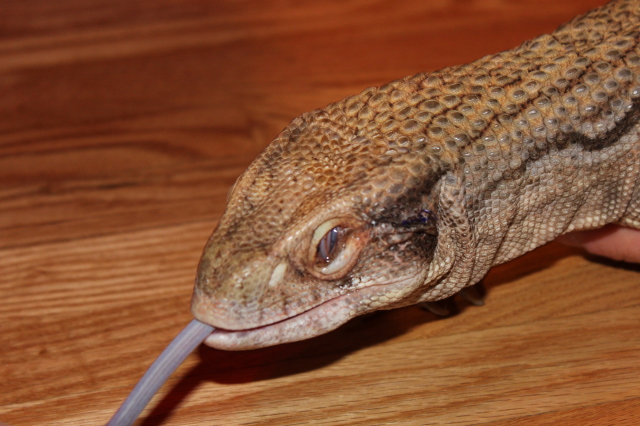 Savannah Monitor eye issue
Question
Savs Eye Savs Eye
Savannah Monito
Savannah Monitor eye issue
Question
Savs Eye Savs Eye
Savannah Monito
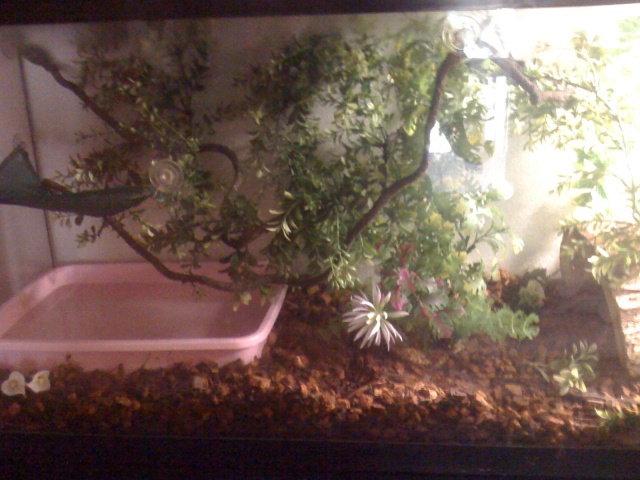 Chinese Water Dragon Not Opening Eyes
QuestionQUESTION: Hello, my name is Morgan and Im an ow
Chinese Water Dragon Not Opening Eyes
QuestionQUESTION: Hello, my name is Morgan and Im an ow
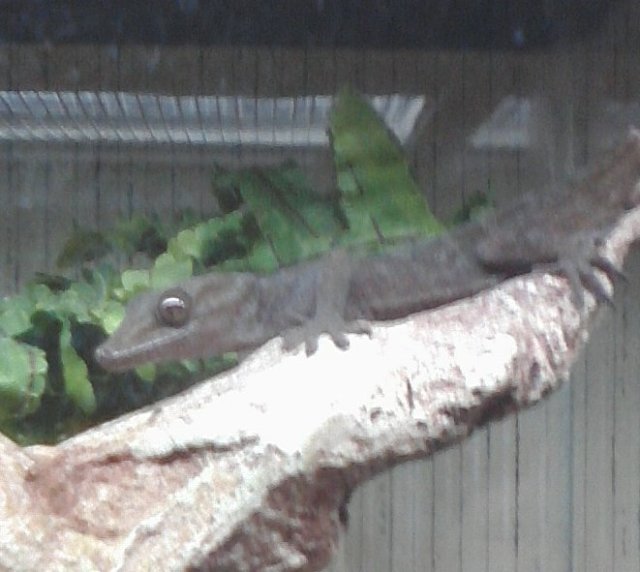 frank
Questiongidget
QUESTION: Well, Ive been research
frank
Questiongidget
QUESTION: Well, Ive been research
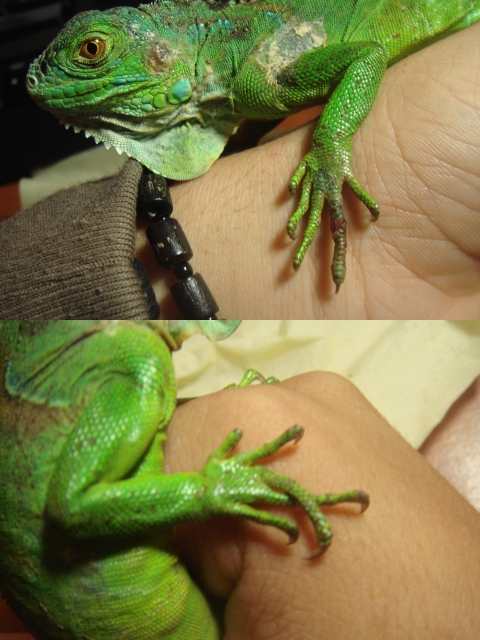 Iguana toe problem...
Question
toe problems
Hey there,
I adopted a baby iguan
Iguana toe problem...
Question
toe problems
Hey there,
I adopted a baby iguan
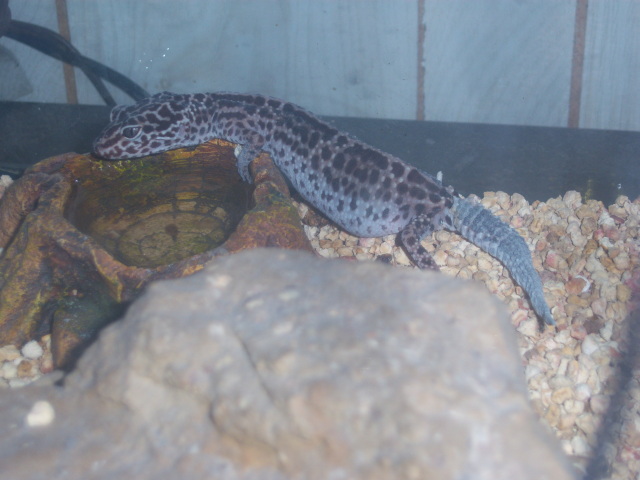 african fat tailed leopard gecko
QuestionQUESTION: My son got Lizzie from my aunt after
african fat tailed leopard gecko
QuestionQUESTION: My son got Lizzie from my aunt after